Rubus ursinus × R. idaeus
When I was seventeen years old, I visited Knott’s Berry Farm with my then-boyfriend (now-husband) and his family on a spring break trip to southern California.
He’d grown up enjoying the famous boysenberry pie and chicken dinners at Knott’s – plus the thrilling rides – and couldn’t wait to share all of that with me.
Until we arrived, I thought we were headed to a boysenberry farm crossed with a theme park. But as it turns out, this was not the case.
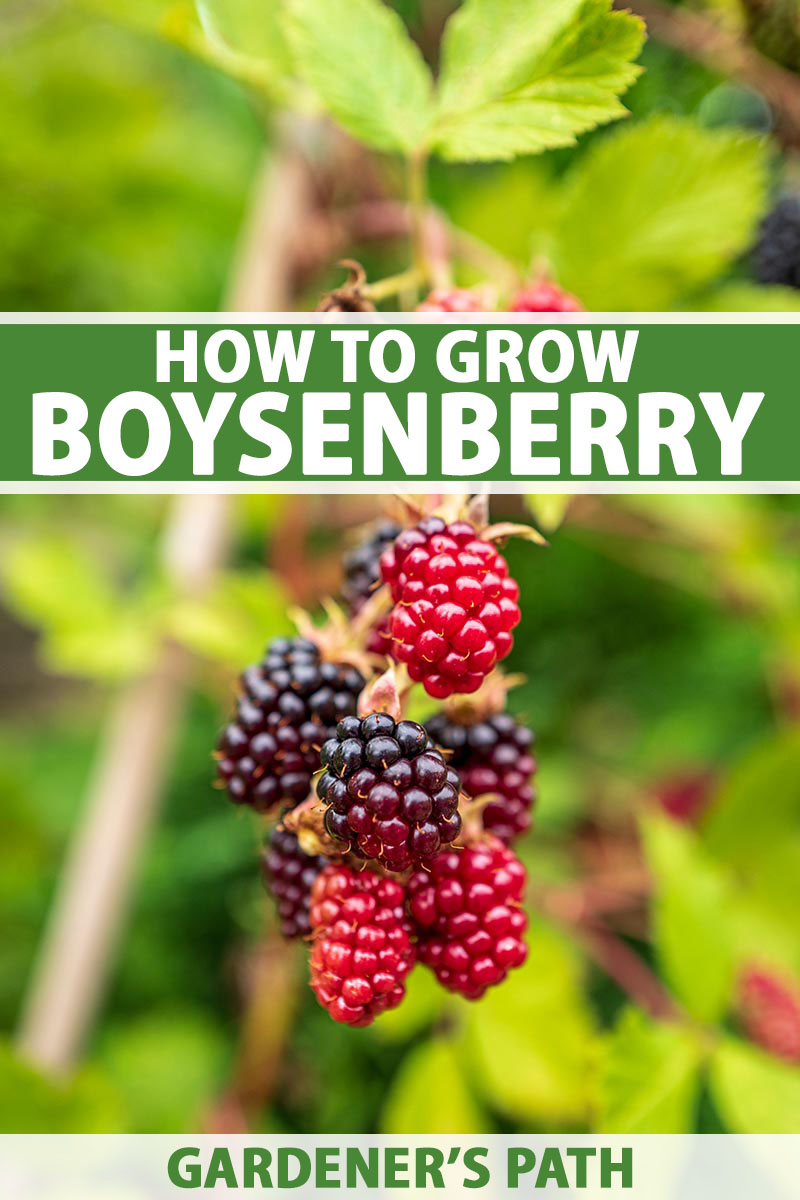
We link to vendors to help you find relevant products. If you buy from one of our links, we may earn a commission.
While they still serve lots of boysenberry-infused food items, Knott’s is purely an amusement park these days.
That first day at Knott’s, the first roller coaster I went on nearly made me pass out. I’m not good with thrill rides.
But I’m excellent at eating pie. And that juicy slice of boysenberry heaven that I enjoyed was the shining star of my first trip to Knott’s.
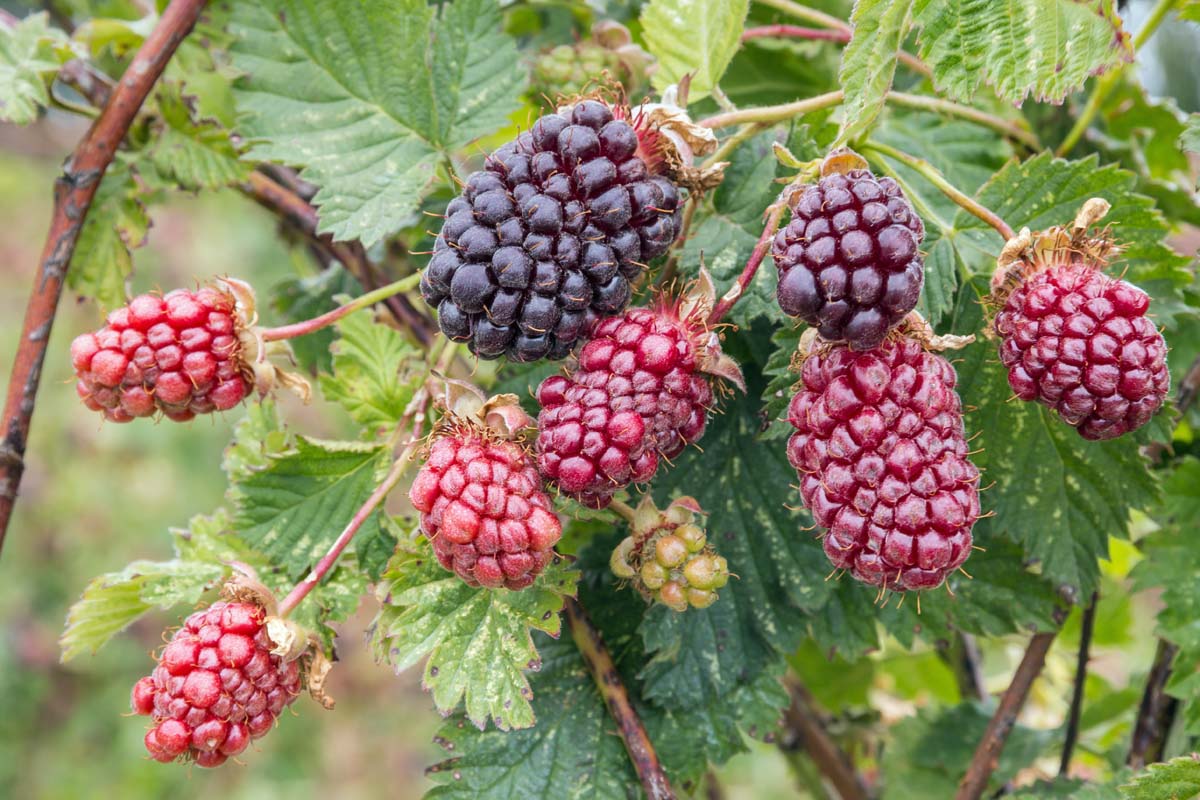
Like raspberries and blackberries, these berries are actually ‘aggregate fruits’ rather than true berries, but we call them berries anyway.
They are large, juicy, and thin-skinned, and they mature from May through mid-July.
They begin to go bad just a few days after picking, and therefore aren’t typically shipped fresh to grocery stores by commercial growers.

What does this mean for the average boysenberry lover? Unless you want to eat them frozen or canned, you have to grow them yourself.
If you’ve ever grown other types of brambles like blackberries or raspberries, you’ll ace growing your own boysenberries.
But even if this is your first foray into cultivating this type of fruit, our guide will help you to grow the juiciest, tastiest boysenberries you’ll ever find.
What You’ll Learn
Cultivation and History
This hybrid berry has four parents: the blackberry, raspberry, dewberry, and loganberry.
Like roses, apples, cherries, and almonds, it’s a member of the family Rosaceae. Belonging to the genus Rubus, it’s a bramble like many other Rubus species, and most varieties feature woody, thorny stems.
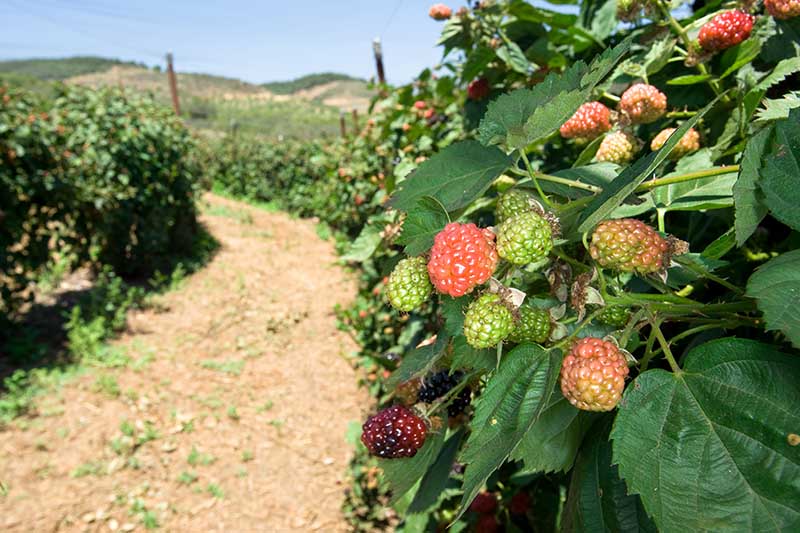
Boysenberries echo the flavor of blackberries, but with an added sweetness and tang. And at about 8 grams in weight each, they’re bigger than blackberries, which typically max out at 5-7 grams.
California horticulturist Rudolph Boysen bred this juicy hybrid in 1923, but even with successful grafting and fruiting, was unable to turn it into a favorite among commercial growers.
After a farming accident caused him to abandon his new berry, his friend Walter Knott picked up the bushes, which were struggling to survive.
Knott nursed them back to life, named them after his friend, and started selling them at his berry stand in Buena Park, California.
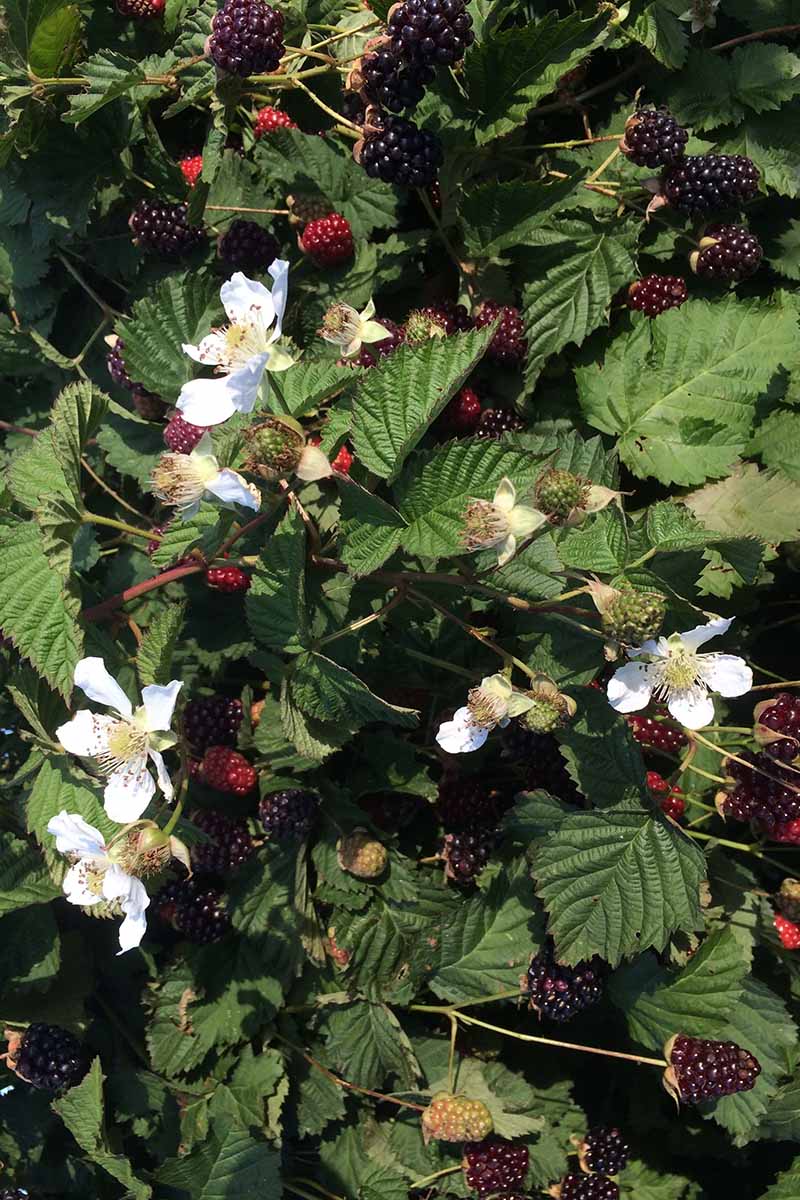
The rest is Knott’s Berry Farm history. This berry became the driving force behind the theme park’s success, and it’s still celebrated and served at the park today.
Somewhat surprisingly, the biggest national producer and exporter of boysenberries is New Zealand. The berry is also grown commercially in the US in parts of Oregon and California. And of course, home gardeners can grow the berry in any location that falls in USDA Hardiness Zones 5-9.
Or if you’re like me, you’ll brave planting a bush in Zone 4 – because gardeners can’t always follow every rule, am I right?
It’s worth the effort. Not only are boysenberries extra tasty, but they also provide several key health benefits, which you can read more about here.
Read on to learn how to propagate this tasty, purplish-red berry at home.
Boysenberry Bush Propagation
There are four main ways for home gardeners to propagate boysenberries. You can plant a dormant bare root, a small plant from a nursery, a cutting from an existing plant, use a method called tip layering, or take a root cutting.

And while you could maybe attempt to grow this plant from seed, it won’t really be a boysenberry, per se, and this technique is very rarely used.
As a hybrid, the seeds won’t produce an exact copy of the parent plant. You simply won’t get a true boysenberry if you try this method.
In fact, many nurseries that sell boysenberry plants propagate them in a lab, using a tissue culture method.
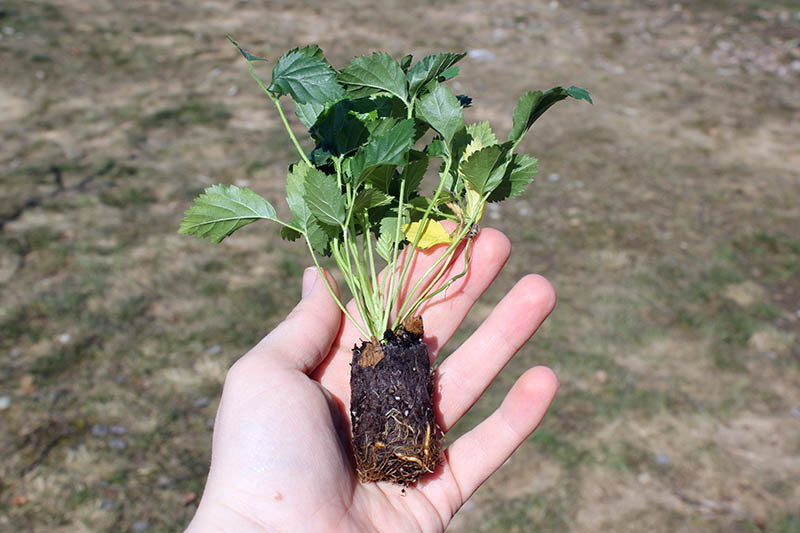
Before I explain how I planted my transplant, a few points of clarification:
First, while boysenberry roots are perennial, the plant sends up new biennial canes, or stems, each year.
First-year canes, called primocanes, are green and produce only leaves, not fruit. During the summer, they acquire brown bark.
Then they go dormant for the winter and reawaken in the spring as floricanes, or second-year canes. Read more about the differences between primocanes and floricanes.
Floricanes produce berries on green stems called laterals.
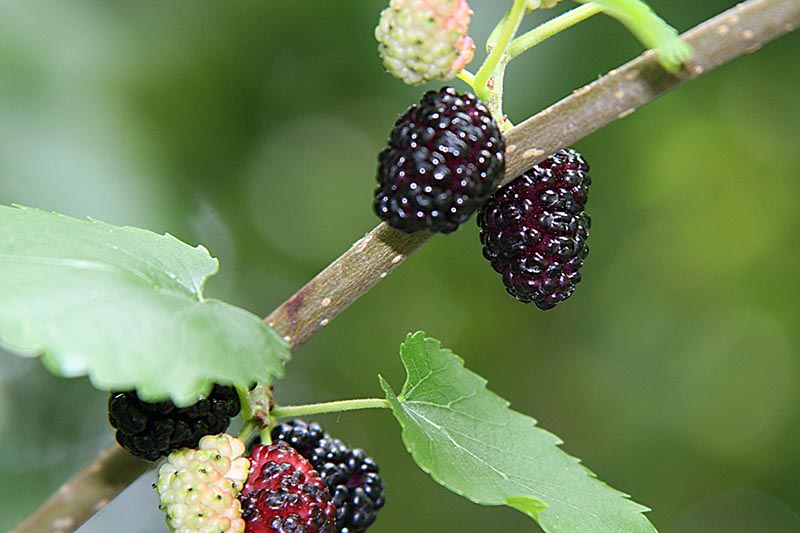
Floricanes die after producing berries in midsummer. But the boysenberry plant will continue to produce new primocanes each year with no prompting from you!
And not only that, but the root of the original plant will create rhizomes – essentially little underground bridges – to establish new roots a few inches away. Each new root will send up canes of its own, called suckers.
Some gardeners pull suckers away to allow the original plant to flourish, while others welcome the new plants.
You can learn all about the different ways to propagate boysenberries in this guide.
Transplanting Nursery Starts
My tissue-cultured baby boysenberry arrived in the mail, packaged with damp towels.

Because I live in a colder climate and frost regularly settles on my yard overnight, I decided to put my plant in a container, in commercial potting mix for now, ready for transplant in spring.
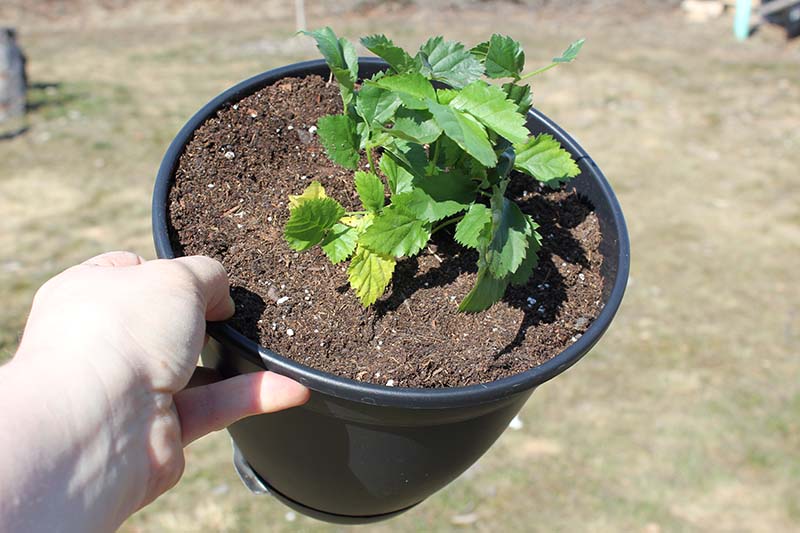
Two weeks after the average last frost date in your area, you can set your baby plant outside. To do this, dig a hole the size of the root ball, place the transplant inside it, and gently tamp the soil back over it.

Then, give it an inch or two of water. I let my son water our newly planted boysenberry. You’ve got to encourage those gardening skills while they’re young!
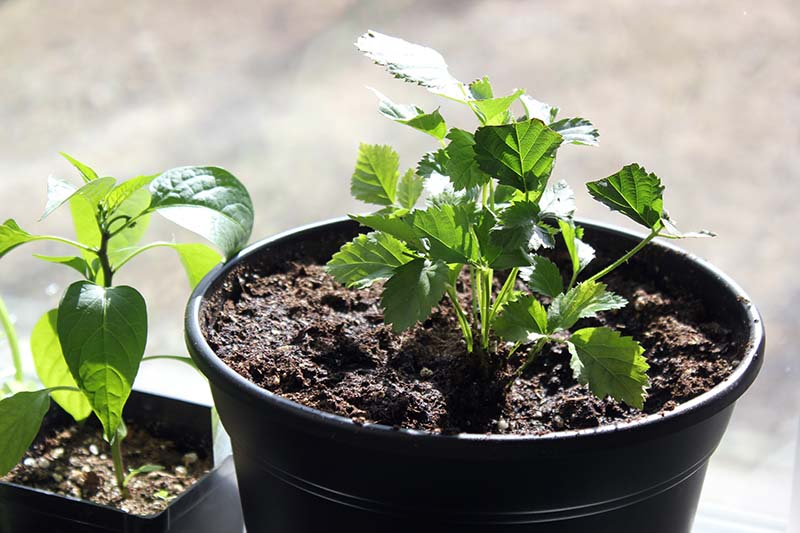
Since it’s still cold outside here, I set my plant on a sunny windowsill indoors.
When the temperature starts to warm up, I’ll repot it in a larger container, and put it outside for the summer.
How to Grow Boysenberries
Boysenberry plants need a full sun location, with six to eight hours of sunshine per day.
Plants prefer an organically-rich, well-draining soil, with a pH of 6.0-7.0. When you set out your transplants you can fertilize with 20-20-20 (NPK), according to package instructions, or mix in some well-rotted manure or compost.
You’ll only need to fertilize boysenberries upon planting, and once a year in the springtime thereafter.
Keep the plants evenly moist but not soaked, giving them one to two inches of water every week. To check the soil moisture, stick your finger down about an inch.
While boysenberries can technically grow without support, it’ll be easier to maintain your plants and harvest fruit if you grow them against a wall or trellis.

Keeping your plants cool in hot temperatures is important, so if you live somewhere warm, provide your boysenberries with partial shade during the day, and mulch with a light-colored material.
Those of us in cooler zones may need to mulch with dark-colored material to trap summertime warmth.
In the winter, you’ll need to cover the entire plant and root area with a thick layer of straw as soon as temperatures begin to dip toward 32°F. This will help it to stay warm during the winter, come what may.
Read more about caring for boysenberries during winter.
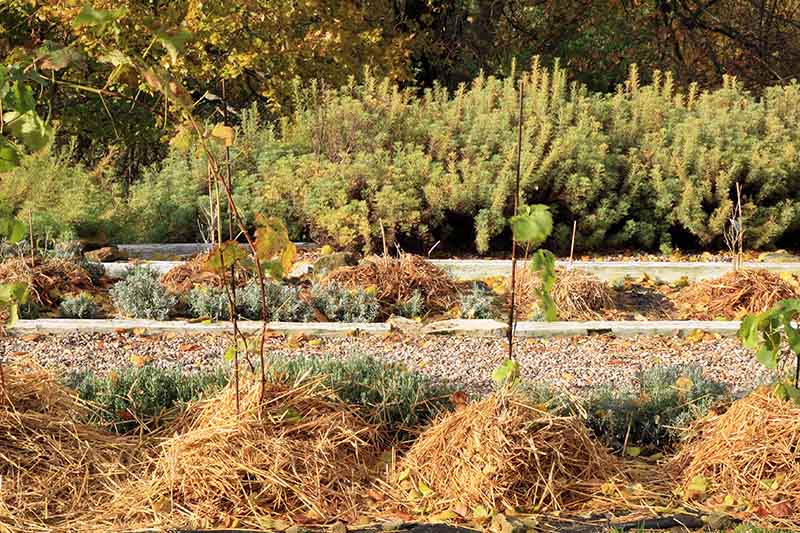
No matter what zone you live in, you will need to prune dead floricanes off the plant every fall or early in winter when they’re going dormant. This helps keep the plant tidy and prevents disease.
Prune primocanes until there are just 5-7 per plant, and trim the laterals back to 12 inches or shorter.
This will help to ensure that your plant is ready to focus its energy on producing new canes and delicious fruit the following spring.
Growing Tips
- Fertilize as soon as new growth occurs in the spring
- Keep moist but not wet
- Provide light-colored mulch and partial shade in warmer climates, and dark mulch and straw in cold areas
- Prune every fall or early winter, when plants are going dormant
Boysenberry Cultivars to Select
Since it’s already a somewhat rare hybrid, there aren’t many different cultivars available to home growers. But here are a few selections for your home garden.
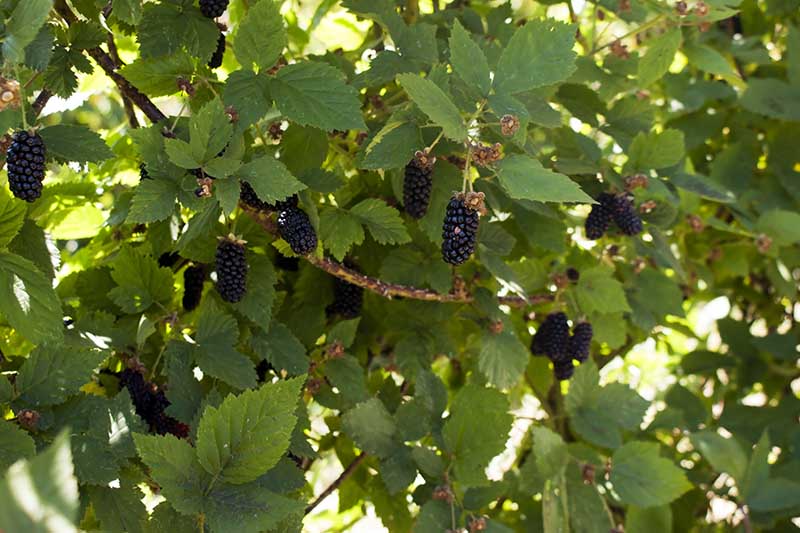
In the United States, there are two common types of boysenberry: thornless (Rubus ursinus var. loganobaccus) and the non-thornless hybrid (Rubus ursinus × Rubus idaeus)
Even if a plant is labeled as thornless, however, it will likely grow some thorns on the initial shoots, and sometimes even on canes.
My plant is supposed to be thornless, but it’s got spiky thorns on all of the young vines.
“United States” Boysenberry
Okay, so I made this species name up. The truth is that many US-grown plants are simply labeled “boysenberry.” It’s often unclear whether varieties available from plant nurseries are going to be thorny or thornless.
But that doesn’t matter much. What you do know is that ‘Boysenberry’ is a delicious cultivar with delicate white flowers, juicy berries, and a sweet-tart flavor.
You can find an upright variety to plant in your garden from Burpee.
Brulee
A popular cultivar in New Zealand, ‘Brulee’ is difficult to find in the US, unless you can get a New Zealand-based farm to ship a plant to you.
With thornless canes and plump, yet firm berries, ‘Brulee’ delivers delicious, sweet-tart flavor to your table.
Mapua
Another New Zealand variety, ‘Mapua’ boasts extra-bold flavor and large reddish berries.
It’s another variety you won’t easily find in the United States, but if you’re gardening in New Zealand, you’re in luck.
Tasman
A (mostly) thornless variety that produces medium-sized fruit, ‘Tasman’ offers reliably high yields and is a New Zealand favorite.
It’s another one that you’ll have to enjoy when visiting New Zealand, as it’s not available in the US.
Managing Pests and Disease
After all the work you put in to keep your boysenberries healthy and happy, the last thing you want is pests or diseases to ruin your crop. Here are the most common maladies and how to prevent or treat them.
Omnivores
There’s one major berry predator to watch out for during fruiting season, and that’s the birds. Here’s how to keep them from devouring your crop.
Birds
Do you have birds in your yard? If the answer is yes, then you’ll probably have a bird problem once your boysenberries produce fruit. Birds are notorious for pecking away every last bit of juicy goodness from a vine. Not cool at all.
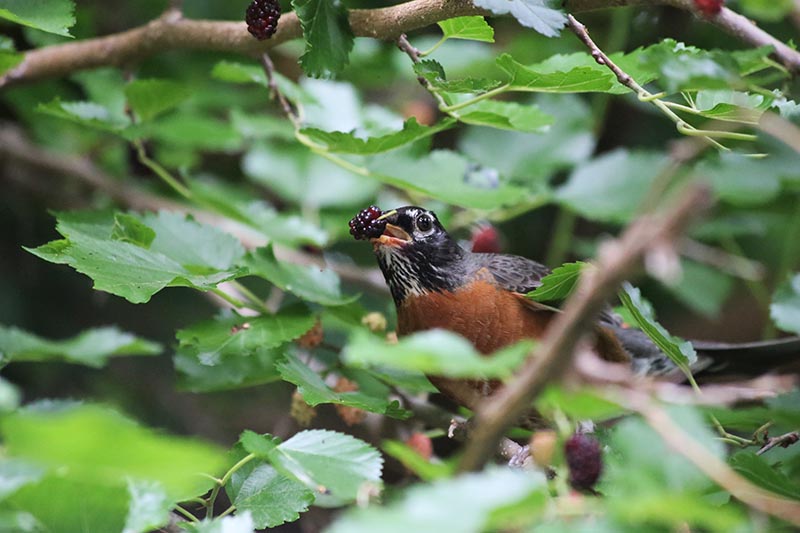
There are two things you should do to help keep your berries safe. First, hang bird feeders in your yard and keep them filled with birdseed.
Make sure the feeders are far from the berry patch, of course. This will help the birds stay fed and hopefully dampen their appetite for your fresh berries.
The second thing to do is to cast bird netting over your bushes as soon as berries appear, like this reusable netting from Gardener’s Supply.
Stake it down around your vines, or use garden hoops or poles to make a small enclosure.
Insects
Which insects bug boysenberries the most? These four pesky critters.
Aphids
Is it any surprise that these greenish-yellow or grayish pests are on this list? Sap-sucking aphids cause leaves to crinkle and wilt, weakening a plant’s health.
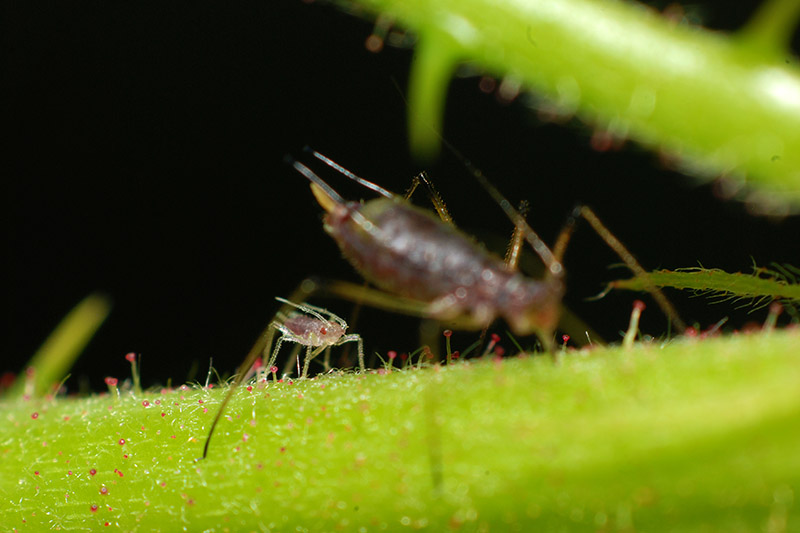
Usually, minor aphid infestations don’t bother boysenberries enough to warrant intervention.
Ladybugs and other predatory beneficial insects will often take care of aphid populations, but if you’re having serious trouble with them, spray with a neem oil-based insecticide or insecticidal soap that’s safe for use on brambles.
Cane Borers
Both red-necked and raspberry cane borers can plague boysenberries.
Larvae of the red-necked cane borer (Agrilus ruficollis), a red and black beetle at maturity, bore into canes and cause swelling and damage at the base of the stems.
Remove and burn or otherwise dispose of affected canes, and spray neem oil on the plant to help prevent reinfestation.

Raspberry cane borers (Oberea bimaculata) start their dirty work at the top of a cane, causing leaves to wilt along the way. Adult black-and-yellow beetles are the main culprits, as they puncture holes in new shoots and lay their eggs inside.
Prune away infected canes, and spray with neem oil or insecticidal soap to help control these pesky bugs.
Raspberry Sawfly
As adults, these tiny, six-millimeter wasps (Monophadnoides rubi) eat holes in the leaves, as do their 12-millimeter green larvae.
The larvae especially enjoy eating new growth on primocanes, which isn’t good for next summer’s berry crop. Plus, they’ll ultimately skeletonize your leaves.
To control these leaf thieves, use a natural spinosad-based powder to kill the larvae, like this one from Arbico Organics.
Red Berry Mites
During dry spells, watch out for signs of these microscopic, spidery, red mites (Acalitus essigi).
They can cause leaves to curl, turn yellow, and take on a speckled appearance. They’ll even affect clusters of berries and prevent them from ripening – even on nearby plants.
To control these mites, use a botanical oil-based mite control spray like this one from Arbico Organics.
Disease
Check your plants daily to make sure they aren’t developing signs of these common bramble diseases.
Anthracnose
Caused by the fungus Elsinoe veneta, anthracnose is an unsightly disease.
Also called dieback, it causes the ends of infected canes to, well, die back.
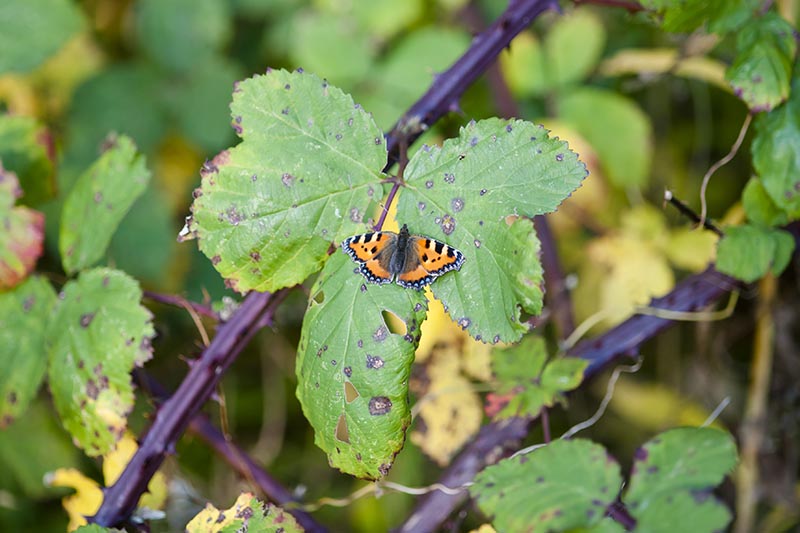
First signs of infection include little purple-gray spots on leaves and new shoots.
While this plant should survive any brushes with Anthracnose, try treating it with fungicide during the last stages of dormancy in the winter to prevent a repeat summertime infection.
Cane Gall, Crown Gall, and Hairy Root
Three types of bacteria cause these diseases: Agrobacterium rubi (cane gall), A. tumefaciens (crown gall), and A. rhizogenes (hairy root).
Cane gall is exhibited by large galls that cause the woody stems to split open, while crown gall causes a similar problem in the root area of the plant.
Hairy root causes a bunch of skinny, infected roots to grow off the main root.
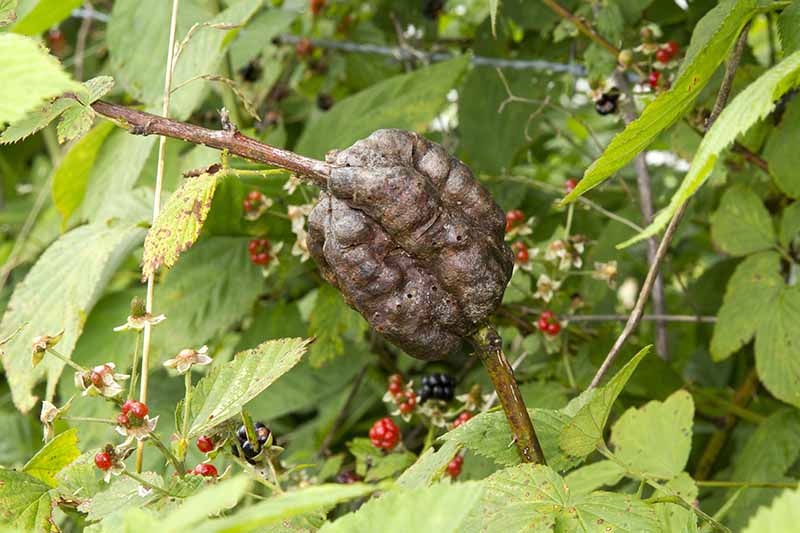
These problems can be spotted in the nursery before you buy a plant, if you look closely.
If infection arises once you’ve already got a plant in the ground, you’ll unfortunately have to uproot the plant, destroy it, and plant something different in the same area later on, preferably after cleaning out the diseased soil.
All three of these types of bacteria can live in the soil for years.
Often, these diseases are introduced after a natural or mechanical injury – such as that caused by pruning. Make sure you disinfect all of your tools before you prune in the fall, and between plants.
Cane and Leaf Rust
Another unsightly but non-deadly fungal infection caused by Kuehneola uredinis, cane and leaf rust leaves yellow blisters on canes and leaves in the summertime.
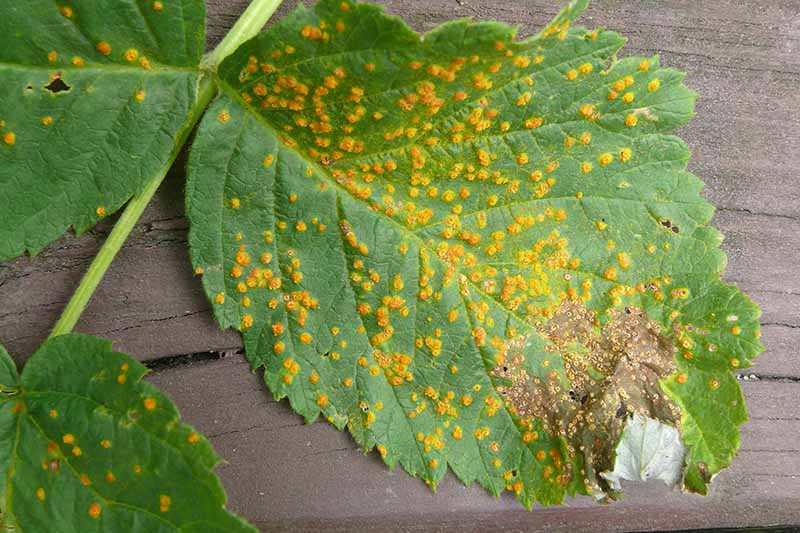
If left untreated, the canes will dry out and crack, so it’s best to prune infected canes off the plant and burn or otherwise dispose of them.
The rest of the plant should remain unaffected and fruitful if you prune away the diseased portions.
Orange Rust
This unsightly disease is caused by not one but two different types of fungi: Arthuriomyces peckianus and Gymnoconia nitens, and it is devastating.
Leaving unmistakable bright orange spots all over the front and back of leaves, there’s no treatment for it. Remove affected plants and destroy them to prevent it from spreading to the surrounding plants.
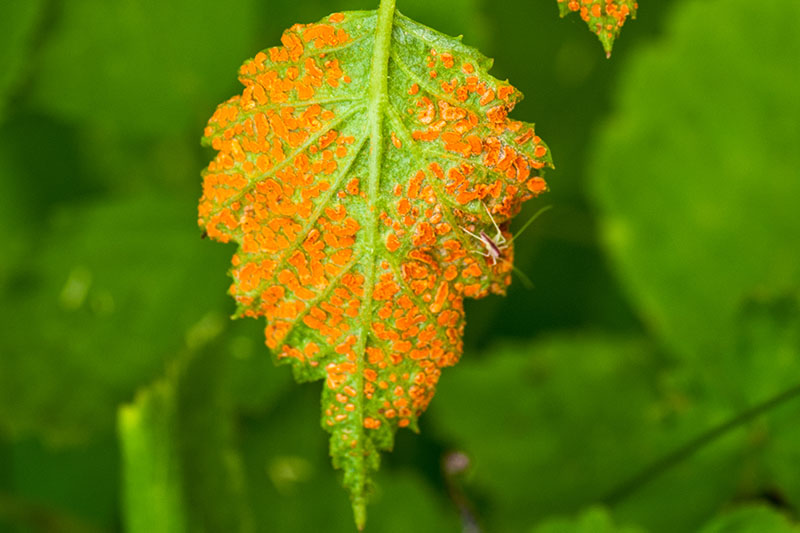
At the nursery, carefully check leaves for telltale yellow dots that will soon turn orange.
If there are any wild roses, berries, or other brambles in your yard, plant boysenberries well away from them, so they won’t share potential diseases.
Pruning regularly and making sure to space your plants at least three to five feet apart helps, too, by improving the air circulation and overall health.
Harvesting Boysenberries
Early morning is the best time to harvest boysenberries, which are dark purple and easy to tug off the stem when ripe.
They won’t ripen all at once, and instead tend to ripen a few at a time, over the course of a month, usually sometime between mid-May and mid-July, depending on the growing zone.
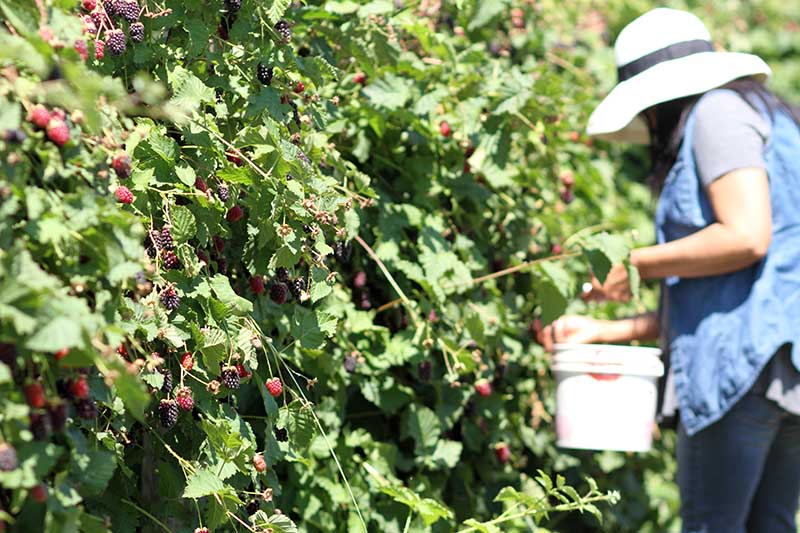
Enjoy stepping into your garden in the cool breath of morning during this period, to see what’s ripe and pluck the firm berries from their stems.
Put them directly in a plastic container to eat fresh, or prepare your harvest for preservation. You can keep fresh berries in the refrigerator for up to three days.
Read more about harvesting boysenberries here.
Preserving
To freeze these homegrown treats for later enjoyment, lay them out on a baking sheet lined with wax paper and pop it in the freezer until they’re completely frozen.
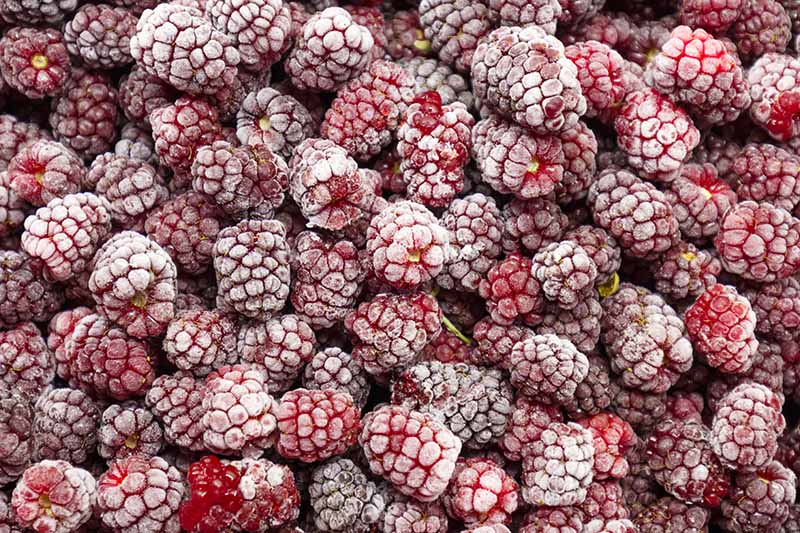
Then transfer them to a freezer bag or airtight container and place back in the freezer. Enjoy within six months for the freshest taste and best texture.
If you’re the canning type, boysenberries are an excellent candidate for making jam. Check out these pressure canning tips from our sister site, Foodal to get you started on the road to deliciousness.
Recipes and Cooking Ideas
You can toss fresh or frozen berries into smoothies, pies, tarts, and any other berry-based treat you love.
These blueberry muffins, also from Foodal, are on my must-make list once my plant produces, but of course I’ll be using boysenberries instead of blueberries.
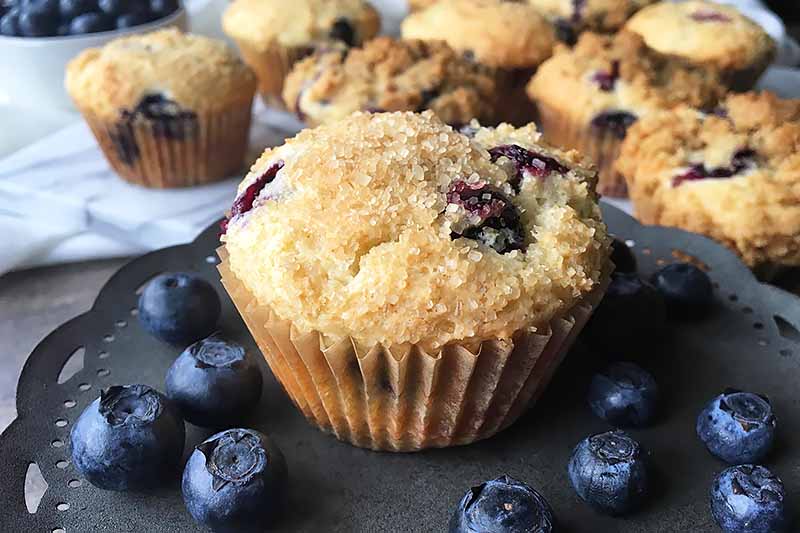
Some people like to get creative with boysenberries and use them in savory dishes, too.
At Knott’s Berry Farm’s annual boysenberry festival, you’ll find all sorts of wacky dishes on the menu: boysenberry gumbo, barbeque sauce, ketchup, and more.
Use your imagination to create your own scrumptious boysenberry dish!
Quick Reference Growing Guide
| Plant Type: | Perennial berry bush | Water Needs: | Moderate |
| Cultivated in: | New Zealand, United States | Maintenance: | Moderate to high |
| Hardiness (USDA Zone): | 5-9 | Tolerance: | Frost |
| Season: | Spring, summer | Soil Type: | Organically rich |
| Exposure: | Full sun, part shade | Soil pH: | 6.0-7.0 |
| Time to Maturity: | 1 year | Soil Drainage: | Well-draining |
| Spacing: | 3-5 feet | Companion Planting: | Blueberries, peas, tansy |
| Planting Depth: | 2 inches, depends on style of propagation | Avoid Planting With: | Peppers, potatoes, tomatoes |
| Height: | 5-6 feet | Family: | Roseaceae |
| Spread: | 4-5 feet | Genus: | Rubus |
| Pests & Diseases: | Birds, aphids, cane borers, raspberry sawflies, red berry mites; anthracnose, cane gall, crown gall, hairy root, cane and leaf rust, orange rust | Species:: | R. ursinus × R. idaeus |
A Berry Refreshing Summer Treat
Now you’re ready to grow your own boysenberries, which will refresh your palate like none other – especially if you eat them fresh.
Have you ever grown boysenberries? Let us know your tips and tricks in the comments below!
And if you are growing berries in your garden, check out these berry helpful articles next:

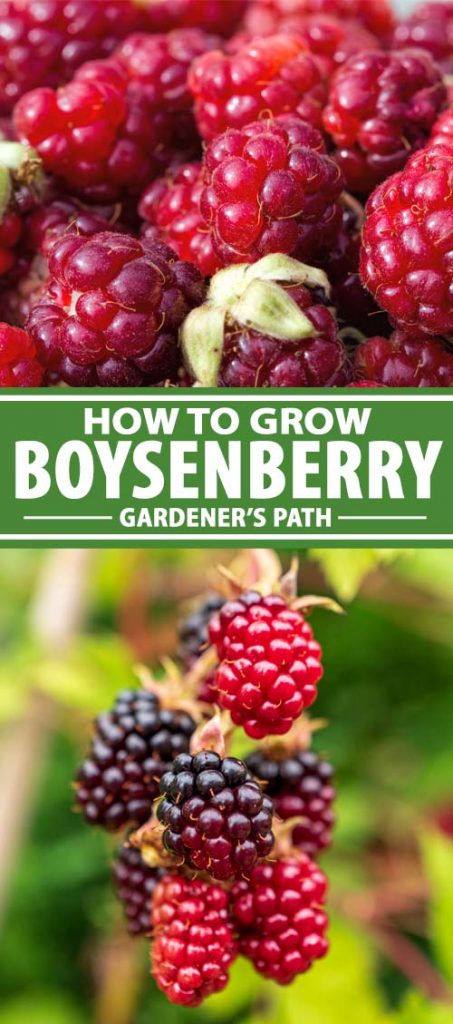
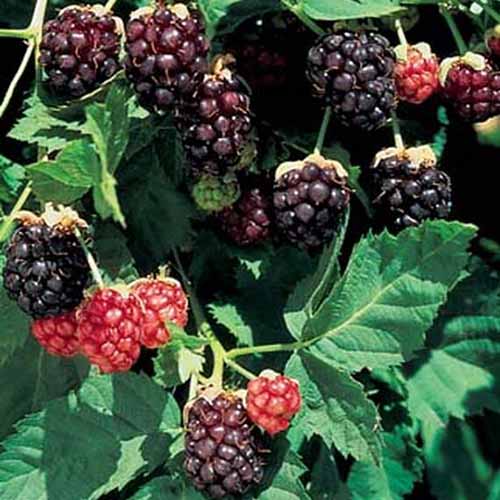

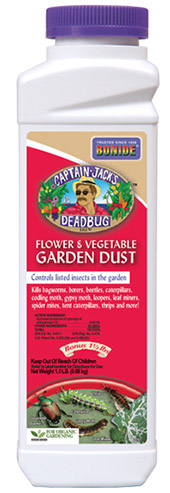
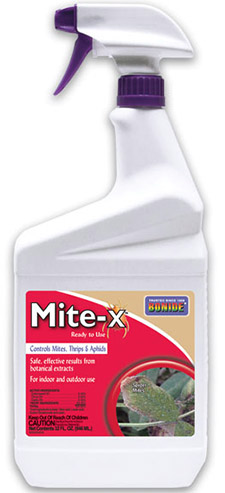
What a wonderful article of the Boysenberry! Such kind remarks and very informative! My parents had boysenberry plants from Knott’s when I was growing up about 30-45 minute drive from Knott’s. Now, since having a family of my own, I’ve always longed for the taste of boysenberry grown in my own yard. I bought a plant at the Knott’s Boysenberry Festival in 2018 and have reaped quite a harvest this year! It’s only the beginning of June and I already have more than 4 Gallon Sized bags of frozen berries in my freezer! That’s just from THIS YEAR’s crop! Last… Read more »
Ken, I’m so glad you enjoyed the article! That’s so neat that you have a plant from Knott’s itself and have attended the Boysenberry Festival. Isn’t it amazing how much fruit the plants can produce?? I hope your tip layering endeavors are successful — please reach out if you have any questions at all!
Happy berrying!
I started growing my four plants. I live in zone seven. Should I cut back the plant during winter?
Hi Robert! Thank you for your comment. I hope your plants are growing well this year! Yes, you should cut the brown, already-fruited canes back to the ground just before the winter hits. Since boysenberries are biennial, you’ll want to leave the green canes (which will be turning brownish by the end of the summer but won’t have borne fruit) intact. You can trim them if you need to, but don’t cut them to the ground. They will be your fruit bearers next year.
Hi Laura, what kind of structure do you recommend for the vine? One stem like a grape or multiple vines coming up spreading out on supports?
thank you
Hi Shane! You can definitely allow multiple vines to grow and train them to grow on a trellis or fence, or even a tomato cage.
Hi Laura: Thanks for your history and tips for keeping the boysenberry from being extinct. Growing up in eastern Ohio, northwest Pennsylvania and north central Indiana gave me a chance to experience a lot of wild berry picking at my mother’s side. But I never stumbled across the boysenberry in the wild. The closest was probably the wild blackberry. The rarest I found was the teaberry. It grew as a ground cover with small red fruit maturing in mid-late summer. The fruit had a very delicate flavor. But the plant leaves were robust. You had to have 4-5 leaves, chew… Read more »
George, thank you for sharing your memories of picking berries with your mother. Amazing, isn’t it, how berries can bring us closer together? I love to pick mountain blueberries with my son every summer here in Alaska. 🙂
I was able to to purchase twelve boysenberry plants from Knotts this year before COVID-19 became a full blown pandemic. I even harvested a few berries this summer. Living in Orange County CA our weather is relatively mild during the winter and the canes are still growing now in October. How much watering do the plants need between now and spring?
Hi John! Wow, lucky you! That’s wonderful that you got plants from Knott’s itself. Ah yes, winter weather in OC is comparable to summer weather up here in Alaska where I live! I attended university in Riverside and have family in Lake Forest. 🙂 During the winter in southern California, go ahead and give each plant about an inch of water every week. If you notice the soil drying out, check the moisture level about an inch down. If you feel nothing but dryness, it’s time to add some water. The plants will slow down in their growth, but they… Read more »
Laura, Thank you for your response. By the way I am learning a lot from the article you write Perhaps the added knowledge my brown thumbs will turn slightly green. Am I correct in assuming when the vines grow “dormant” they do not loose all the leaves? PS: Many enjoyable fishing trips to Alaska. Love the beauty and wide open spaces. The frost heaves on the roads and wild fires, not so much.
I’m glad you’re enjoying the article! They may not lose all the leaves down in OC. Here in AK, they do. It all depends on the weather! And yes — AK definitely has lots of beauty, and lots of frost heaves and fires!
Thank you so much. Gave me more helpful info. than anywhere else! I’ve just ordered one. I live on the Sunshine Coast, Qld. Australia [Zone 9 US]. If I follow all your good advice my Boysenberry should be okay. [I’ll plant it where it doesn’t get hot afternoon sun]. Thanks again, Pat
That sounds perfect! I am certain that your green thumb will help it thrive. But if you run into any issues, don’t hesitate to let me know!
Hi, what’s wrong with my boysenberry plants? The leaves are shriveling and drying up on the edges of leaves all of a sudden. We are living in Basin, Wyoming. Moved from Central Valley California a year ago. I have boysenberry plants from California in pots in the house right now. We live in Zone 4 or 5. Probably more zone 4. Is it OK to have boysenberry plants by sunny window by a wood stove? I’m wondering if it’s too warm? Right now I have them in a room that doesn’t have sunshine and it’s around 70*F.
Hmm, they do look stressed. Have you been fertilizing them? Under/overwatering? Putting them under a grow light? Let me know and I’ll try to help you figure this out! In the meantime, they probably would benefit from sunshine and warmth from a woodstove, although they might dry out more quickly.
I have not fertilized recently. I have been watering them when the top is pretty dry. They are in the back room where there is not bright sunshine and it’s the coolest room in house. I’m thinking of putting them by the wood stove and the patio doors where there is lots of sunshine.
Maybe water them a little more often — and fertilize. How are they doing now?
I am confused I was under the impression that boysenberries are poisonous especially their leaves and the fruit if eaten raw I just bought a boysenberry plant and now I’m confused if I should take it back
Boysenberries are not poisonous. They are a cross of several delicious, edible berries: blackberry, raspberry, dewberry, and loganberry.
Hi Laura, this was a great article! I have a boysenberry which I am trying to keep in a container since I rent. I have a question about the suckers of which I have many. I thought (until I read this article) that they were floricanes for next near. Do the do the floricanes look smooth like the primocanes? If I am containering, should I then trim the suckers? They are quite thorny and are really getting long but now I’m sad wondering if they took energy from the main plant & that why I had so few berries. It… Read more »
Hi Lourdes! I’m sorry I missed this comment. Could you send a photo of the plant? That might help me help you. 🙂
I cut the branches on my 1st year boysenberry bushes all the way back, did I ruin the plants?! 🙁
Hi Cindy! It may grow new primocanes. Just keep taking care of it — how is it doing now?
Love the bit that you mentioned NZ as I live here and my thornless boysenberries are just incredible. I’ve convinced so many of my friends to grow from cuttings I pass to them! The fruits are juicy, sweet if I beat the birds first. It is large too, around 4cm in length.
That’s so wonderful to hear! Ah yes, those birds can be a nuisance sometimes.